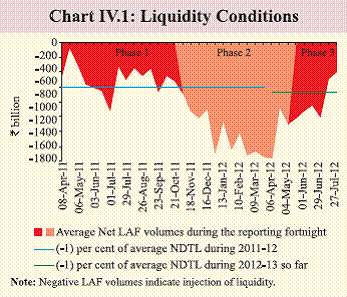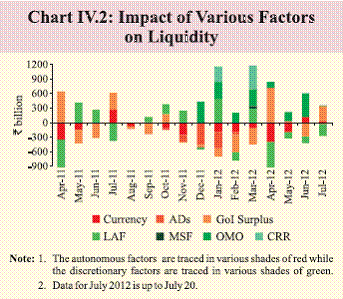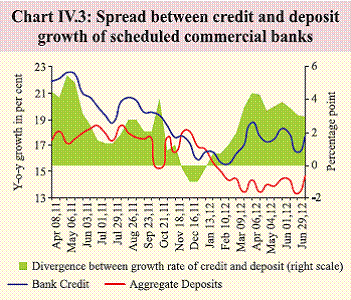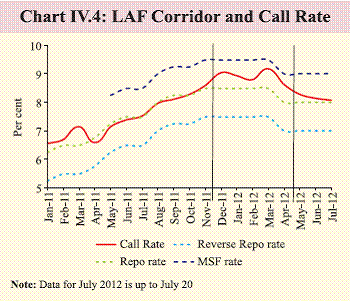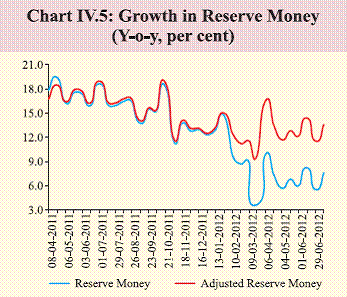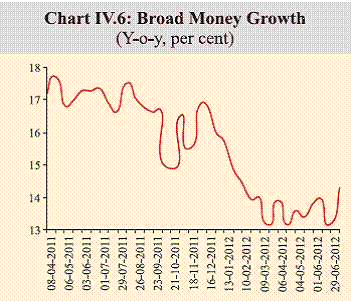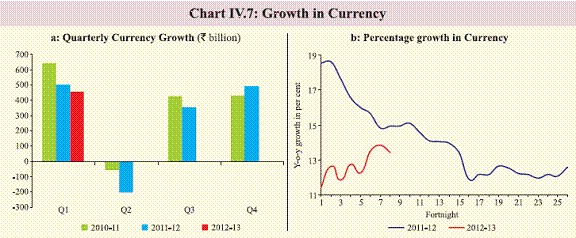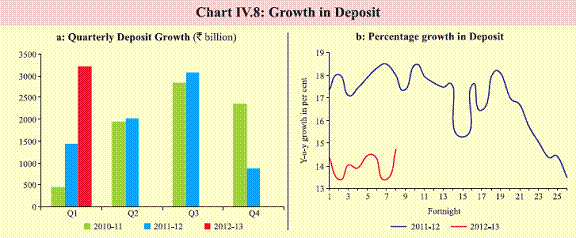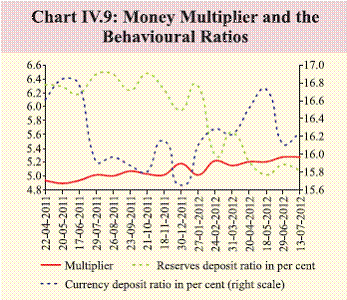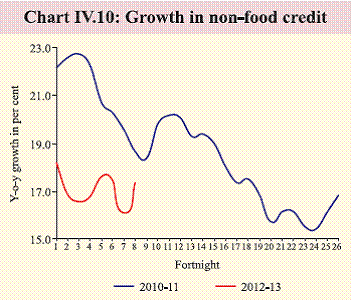 IST,
IST,
IV. Monetary and Liquidity Conditions
While continuing to manage the growth-inflation trade-off, the Reserve Bank reduced the repo rate by 50 basis points in April 2012. Monetary conditions have gradually eased in 2012-13 so far as a result of the two-stage reduction in the cash reserve ratio in Q4 of 2011-12, the repo rate cut and significant depreciation of the exchange rate. Active liquidity management by the Reserve Bank by way of sizeable open market purchases and other policy measures has helped correct the excessively tight liquidity that prevailed during the latter part of 2011-12. Besides the gradual pick-up in growth in monetary aggregates in 2012-13 so far, there has been a pick-up in non-food credit which as of mid-July 2012 was growing marginally above the indicative projection for 2012-13. Reserve Bank front-loads rate cut using the available monetary policy space IV.1 In April 2012, the Reserve Bank reduced the repo rate for the first time in three years. Even as inflation remained the main concern, the policy rate was reduced by 50 basis points on account of moderation in growth below its post-crisis trend (Table IV.1). While it was recognised that the deviation in growth from its trend was modest, the slowdown, nevertheless, was expected to contribute to some moderation in core inflation. The cumulative impact of past monetary tightening was expected to moderate inflation further through slower growth. IV.2 Inflation has, however, persisted above the level consistent with sustainable growth.
When the Reserve Bank undertook the frontloaded rate cut action in April 2012, it clearly enunciated that upside risks to inflation persisted and space for further reduction in policy rates was limited. This space was further constrained by lack of credible action to curtail subsidies and related expenditure by the government. Also, there were a number of factors other than monetary policy actions behind the growth slowdown in 2011-12. IV.3 Apart from the rate cut, monetary conditions eased as a result of softening impact on interest rates of the 125 basis points reduction in the cash reserve ratio (CRR) during Q4 of 2011-12 and the significant exchange rate depreciation (about 10 per cent in Q1 of 2012- 13 and about 20 per cent cumulative since August 2011). The monetary easing during Q1 of 2012-13 has significantly corrected the tightness in monetary and liquidity conditions witnessed during Q4 of 2011-12. M3 expansion during 2011-12 at 13.1 per cent was below the indicative projection of 15.5 per cent. Low reserve money expansion at 9.6 per cent (adjusted for CRR changes) contributed to lower expansion of money supply. Reserve money creation has improved during 2012-13 so far, and deposit creation and consequently, monetary expansion is within sight of indicative projections for the year (Table IV.2).
Liquidity deficit eases in response to active management and measures taken by the Reserve Bank IV.4 There was a significant easing of liquidity deficit in Q1 of 2012-13, and the extent of deficit returned to the Reserve Bank’s comfort level of one per cent of net demand and time liabilities (NDTL) in July 2012 (Chart IV.1). This was primarily on account of large scale open market purchases by the Reserve Bank as also measures such as enhancing of the limit of export credit refinance (ECR). IV.5 There was a distinct period of liquidity tightness that prevailed from November 2011 to early April 2012. The liquidity squeeze started in November 2011 on account of large scale forex intervention by the Reserve Bank as well as the usual high currency demand during the festive season. The squeeze on liquidity persisted into Q4 of 2011-12 as the government built up large balances with the Reserve Bank. There was continued intervention in the forex market while the drain on account of currency persisted due to seasonal factors as well as elections in a few states (Chart IV.2). Moreover, the spread between the pace of credit growth and deposit growth, which had narrowed in the first three quarters of 2011-12 and had in fact turned negative in December 2011, widened again during the fourth quarter. This added a structural dimension to the liquidity deficit (Chart IV.3). The Reserve Bank responded by injecting liquidity through outright open market operations of `1.3 trillion between November 2011 and March 2012 as also CRR cuts that released about `0.8 trillion into the system. Despite the active management, the liquidity deficit persisted at a high level. IV.6 Since April 2012, however, there has been an easing of the liquidity stress in the system. The significant easing was brought about by the Reserve Bank actively managing liquidity through the liquidity adjustment facility (LAF) and open market operations (OMO). The Reserve Bank injected liquidity through outright OMO purchases of `0.8 trillion in the financial year so far, of which `0.6 trillion was through auction route. Also, there was some narrowing of the wedge between the pace of growth of deposit and credit in Q1 of 2012-13. IV.7 In order to provide greater liquidity cushion to banks, the borrowing limit of scheduled commercial banks (SCBs) under the Marginal Standing Facility (MSF) has been raised from one per cent of their NDTL to two per cent since April 17, 2012. This has further helped in steering the monetary policy operating target, the weighted average overnight call money rate, within the formal corridor (Chart IV.4). The movements in the operating target of monetary policy mostly mirror the liquidity position in the system. As noted above, there was a systemic liquidity deficit from November 2011 to early April 2012. This period coincided with the call rate mainly staying above the mid-point of the corridor (i.e., the repo rate) and at times hovering close to the ceiling set by the MSF rate. As liquidity eased in Q1 of 2012-13, the call rate gradually eased back to the mid-point of the corridor. IV.8 To further augment liquidity and encourage banks to increase credit flow to the export sector, the Reserve Bank increased the limit of ECR from 15 per cent of outstanding export credit to 50 per cent with effect from the fortnight beginning June 30, 2012. This amounted to release of additional liquidity support of over `300 billion, equivalent to about 50 basis points reduction in the CRR. The daily average amount of ECR availed increased from `70 billion in June 2012 to `177 billion in July 2012 (up to July 26) . IV.9 As regards the autonomous factors that drive liquidity – currency with the public, intervention in the foreign exchange market and government’s cash position – the first two were largely adverse during the Q1 of 2012-13. There is typically strong demand for currency in April and May coinciding with the rabi marketing season. Also, as there was extreme volatility in the exchange rate, the Reserve Bank sold foreign exchange to authorised dealers in May and June. However, as a large part of the intervention was also in the forward/swap market, drain on rupee liquidity was not very significant. The liquidity stress from the above two autonomous factors was partly addressed by the net drawdown of balances by the government. As noted earlier, the large build-up in the government balance with the Reserve Bank in Q4 of 2011-12 had compounded the liquidity deficit in that quarter. As government spending increased significantly in the first quarter of 2012-13, there was concomitant easing of liquidity. The net effect of government spending during the quarter (June 30, 2012 over March 31, 2012) was release of `549 billion into the system. Reserve money expansion improves in Q1 of 2012-13 IV.10 There was a sharp deceleration in the pace of expansion of reserve money during Q4 of 2011-12. While this was predominantly on account of the CRR cuts, even adjusting for the first-round impact of CRR cut, the adjusted reserve money growth showed a deceleration. As seen earlier, active management of liquidity through OMO, LAF and MSF transactions led to a gradual rise in the rate of reserve money expansion in Q1 of 2012-13 as against the steady deceleration observed in the previous quarters (Chart IV.5). On the liabilities side of the Reserve Bank balance sheet, the growth is explained by the increased demand for currency. Deceleration in broad money growth arrested in Q1 of 2012-13 IV.11 Given the significant primary liquidity injection through OMO purchases and CRR cuts, there has been a pick-up in growth rates of monetary aggregates in 2012-13 so far as against the steady deceleration observed in the fourth quarter of 2011-12 (Chart IV.6). On a y-o-y basis, the growth rate as on July 13, 2012 was lower than the previous year. IV.12 There was a pick-up in demand for currency during the first quarter of 2012-13 as is usually observed in Q1. The y-o-y growth rate was lower than that of the previous year on account of the base effect (Chart IV.7). IV.13 The mobilisation of deposits during the first quarter of 2012-13 was higher than in comparable period of recent years. The y-o-y deposit growth of SCBs at 14.7 per cent on July 13, 2012 is below the indicative projection of 16 per cent for 2012-13 (Chart IV.8). The increase in deposit across the bank groups has, however, been skewed (Table IV.3). Monetary expansion improves with rise in money multiplier IV.14 With the CRR cuts effected in January 2012 and March 2012, there has been a reduction in the ratio of bankers’ deposits with the Reserve Bank to aggregate deposits in the banking system (the reserves deposit ratio). However, monetary expansion remained subdued during Q4 of 2011-12 as increase in money multiplier was not commensurate to the CRR cut as currency demand was high. The relatively higher pace of deposit mobilisation in 2012-13 so far has resulted in lowering both the behavioural ratios. Thus, with the rise in the money multiplier, there has been a gradual pickup in money supply in 2012-13 so far (Chart IV.9). Credit growth in line with the indicative trajectory for 2012-13 IV.15 The y-o-y growth rate in non-food credit increased to 17.4 per cent in mid-July 2012 from 16.8 per cent at end-March 2012 (Chart IV.10). Hence, credit growth is in line with the indicative trajectory of 17 per cent for the year. Anecdotal evidence from bankers suggests that there may be some deceleration ahead. IV.16 Analysis of the sectoral deployment of credit (based on data from select banks which cover 95 per cent of total non-food credit extended by all SCBs) for Q1 of 2012-13 reveals that industries, services and personal loans accounted for 36.1 per cent, 28.6 per cent and 28.6 per cent, respectively, of the incremental credit flow during the quarter. Within industries, nearly two-thirds of the credit flow was to mining and quarrying, rubber, plastic and their products, beverage and tobacco, vehicle, vehicle parts and transport equipment and wood and wood products. Increase in the flow of resources to the commercial sector IV.17 There has been a 41 per cent increase in the total flow of financial resources to the commercial sector during 2012-13 so far, compared to the corresponding period of previous year (data on banks is available till July 13, 2012 while that for most non-bank sources is for up to June only). Unlike the previous year, banks as well as non-banks had a near equal contribution to funding in the economy during the period (Table IV.4). There was about two-fold increase in funding from non-bank domestic sources. The marked increase was on account of higher issuances of commercial papers (CPs), accommodation from all Indian financial institutions (AIFIs), net credit by housing finance companies and LIC’s net investment. Foreign sources of funding, however, declined compared to the corresponding period of the previous year. This is consistent with the slowdown in capital flows during the year so far. Monetary and liquidity conditions are not significantly impinging on growth IV.18 While there has been some rise in nominal and real interest rates during 2011-12, computation of real weighted average lending rates (WALR) suggest that they are currently much lower than the pre-crisis period of 2003-04 to 2007-08 when the investment boom took place. In nominal terms, the WALR averaged 12.4 per cent in the pre-crisis period, but fell to 10.5 per cent in 2009-10. After marginal hardening for two years, the nominal rate stood at 12.7 per cent for 2011-12. The real WALR calculated as nominal rate less WPI inflation fell from an average of 7.0 per cent in the pre-crisis period to 4.0 per cent in the postcrisis period, and was as low as 3.8 per cent in 2011-12 (Table IV.5). The fall is less sharp if GDP deflator is used to calculate inflation instead of WPI. IV.19 A negative relationship between real output growth and real interest rates does exist, and as such real interest rate matters for growth and investment. In spite of the rate hikes, real interest rates are lower than in the pre-crisis period. In this context, there is a need to look at non-monetary factors that are constraining growth as current monetary and liquidity conditions are not impinging upon growth significantly. |
|||||||||||||||||||||||||||||||||||||||||||||||||||||||||||||||||||||||||||||||||||||||||||||||||||||||||||||||||||||||||||||||||||||||||||||||||||||||
Page Last Updated on:






